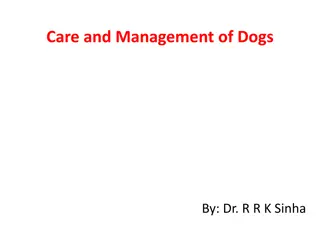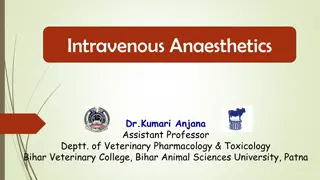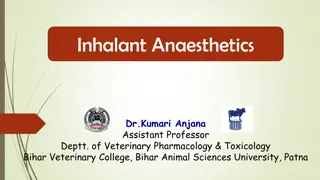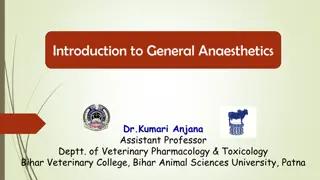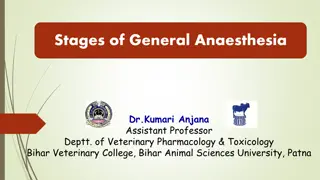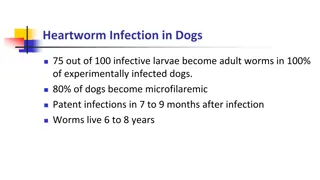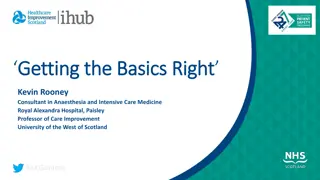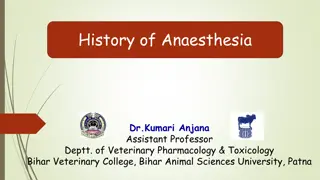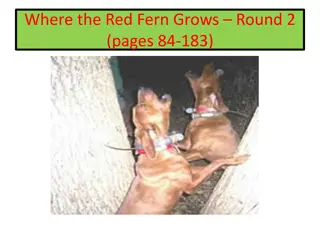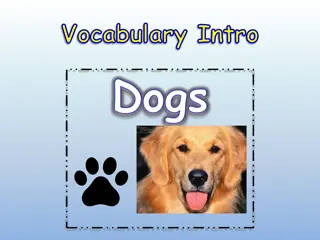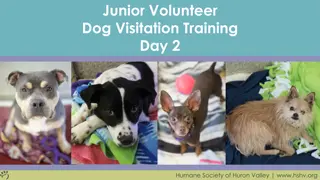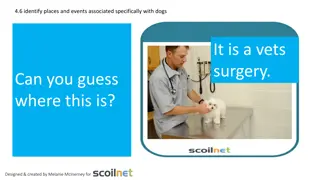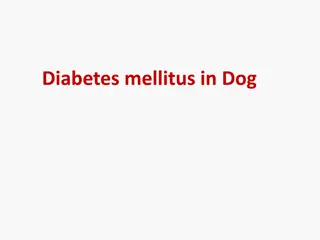Common Anaesthetics and Anaesthesia in Dogs Overview
This content covers the general considerations, definitions, phases, and types of anaesthesia used in dogs. It discusses the importance of selecting appropriate drugs and techniques based on the patient's species, breed, age, health status, and procedure requirements. Key topics include local anaesthesia, regional anaesthesia, general anaesthesia, balanced anaesthesia, and more.
Download Presentation

Please find below an Image/Link to download the presentation.
The content on the website is provided AS IS for your information and personal use only. It may not be sold, licensed, or shared on other websites without obtaining consent from the author. Download presentation by click this link. If you encounter any issues during the download, it is possible that the publisher has removed the file from their server.
E N D
Presentation Transcript
VMD-513 Pet/Animal Breeding, Management, Nutrition and Health Care TOPIC: Common Anaesthetics and anaesthesia in dogs Lecture: 1 (introduction, local anaesthetics and premedicaments)
Introduction to anaesthesia There are no safe anaesthetic agents; there are no safe anaesthetic procedures; there are only safe anaesthetists ROBERT SMITH General consideration: I. Anaesthesia and/or chemical restraint is a reversible process; the purpose of anaesthesia is to produce a convenient, safe, effective, yet inexpensive means of chemical restraint so that medical or surgical procedures may be expedited with minimal stress, pain, discomfort and toxic side effects II. criteria for selection of drugs and techniques A. Species, breed, age and relative size of the patients B. physical status and specific disease process of the patient c. concurrent medications,Demeanour of the patient and severity of pain E. personal knowledge and experience, availability and training of assistants,Length and type of operation or procedure to be performed III. Patient responses can vary because doses and techniques are for the Average, normal, healthy animal: thus it is essential that the practioner knows how to modify anaesthetic techniques.
Definitions Acupuncture: The stimulation of specific trigger points based on traditional Chinese medicine Agonist: a drug that produces an effect by interacting with a specific receptor site(e.g. opioid agonist) Akinesia: Loss of motor response (movement) usually caused by blockade of motor nerves Allodynia: pain evoked by a stimulus that does not normally caused pain Analgesia: loss of sensitivity to pain Anaesthesia: total loss of sensation in a body part or in the whole body, generally induced by a drug or drugs that depress the activity of nervous tissue either locally (peripherally) or generally (centrally). Phases of Anaesthesia: I. preanaesthetic or preinduction period II. Induction to anaesthesia III. Maintenance IV. Recovery V. Post Anaesthetic period
Contd.. Local anaesthesia: Analgesia limited to a local area. Regional anaesthesia: Analgesia limited to a local area produced by blocking sensory nerves General anaesthesia: loss of consciousness in addition to loss of sensation: ideally includes Sedation, hyporeflexia, analgesia and muscles relaxation (induced by single or combination of drugs). Surgical Anaesthesia: loss of consciousness and sensation accompanied by sufficient muscle relaxation and analgesia to allow surgery without pain or movement. Balanced Anaesthesia: produced by a combination of two or more drugs or anaesthetic techniques, each contributing its own pharmacologic effects like sedation, analgesia and muscles relaxation. Dissociative anaesthesia: A CNS state charecterized by catalepsy, analgsia and altered consciousness (Ketamine, Tiletamine). MAC: A term used to imply the minimum alveolar concentration of inhalant anaesthetic required to prevent movement in response to a noxious stimuli in 50% of anesthetized patients
Contd.. Antagonist: a drug that occupies a receptor site but produces minimal or no effect (opiod anta gonist- naloxone) Catalepsy: state in which there is malleable rigidity of the limbs, the patient is generally unresponsive to aural, visual or minor painful stimuli Central desensitization: An increase in the excitability and responsiveness of nerves in the CNS particularly the spinal cord. Euthanasia: loss of consciousness and death without causing pain, distress, anxiety or apprehension Hyperalgesia: an increased or exaggerated response to a stimulus that is normally painful. Sedation: CNS depression in which the patient is awake but calm; a termoften used interchangeably with tranquilization; with sufficient stimuli the patient may be aroused Hypnosis: artificially induced sleep or a trance resemble sleep from which the patient can be aroused from sufficient stimulus Narcosis: drug induced stupor or sedation with or without hypnosis Neuroleptanalgesia: hypnosis and analgesia produced by the combination of a neuroleptic drug (i.e tranquilizer) and an analgesic drugs
Contd. Tranquilization, ataraxia, neurolepsis: state of tranquillity and calmness in which the patient is relaxed, reluctant to move, awake and unconcerned with its surroundings and potentially indifferent to minor pain. CLINICAL JARGON: Bag: The animal was bagged . The rebreathing bag on the anaesthetic machine was squeezed to inflate the animal s lung during anaesthesia Block: the leg was blocked. local anaesthesia was produced at a specific site, locally or regionally. Bolus: A bolus of thiobarbiturate was administered. a specific quantity of drug was rapidly administered intravenously. Breathed: the animal was breathed six times a minute. the lungs were either manually or mechanically inflated. Bucking: the animal is bucking the ventilator. the patient is resisting being artificially (manually or mechanically) breathed. The patient breathes out during inspiratory cycle or in during the expiratory cycle. Crashed: The animal crashed. the patient demonstrated marked CNS and cardiopulmonary depression after the administration of an anaesthetic drug. The animal was crashed induced.
Contd Deep: The animal is in deep stage of anaesthesia. Down: the animal was knocked down or put down. (Euthanasia) Dropped: The animal was dropped. Extubated: The animal was extubated. the endotracheal tube was removed from he airways (opposite is intubated). Preemptive: The patient received preemptive analgesia. the deliberate administration of therapy before the event requiring therapy. TIVA: Total intravenous anesthesia. Topped-off: The animal was topped off with a thiobarbiturate. an additional drug was administered to produce the desired effect.
Use of anaesthetics I. Restraint II. Anaesthesia: to facilitate or permit medical and/or surgical procedures III. Control of convulsions IV: Euthanasia A. Diagnostic imaging (USG, radiography, MRI). B. Cleaning, Grooming, Dental prophylaxis C. Biopsy, radiation therapy, bandaging, splinting, cast application D. Capture of exotic and wild animals E. Transportation F. Manipulation 1. Catheterization 2. Wound care 3. obstetrics G. Assist or control Breathing
Types of anaesthesia (according to route of administration) Acupuncture Infiltration* Intravenous* Buccal Inhalation* Oral Controlled Hypothermia Intramuscular* Rectal Electroanaesthesia Intraosseous Subcutaneous Epidural* Intraperitoneal Topical* Spinal (subarachnoid) Intratesticular Transdermal* Field Block Intrathoracic
Patient evaluation and preparation General consideration I. The preanesthetic evaluation history (history, physical condition and physical examination) dictates the choice and dose of anaesthetic to be used II. The history and physical examination are the basis of patient evaluation III. Laboratory tests are no substitute for a through physical examination IV. A patient airway must be maintained in every patient V. A patient intravenous route must be maintained for all risk patients VI. Anticipate likely untoward events based on history and physical status VII. An emergency cart with appropriate antidotes and antagonists should be maintained. Patient evaluation I. Patient identification A. CASE NUMBER OR IDENTIFICATION B. SIGNALMENT 1. Species, breed, age, sex C. BODY WEIGHT
Contd. II. CLIENT COMPLAINT AND ANAMNESIS: A. DURATION AND SEVERITY OF ILLNESS B. CONCURRENT SYMTOMS OR DISEASE 1. DIARRHOEA, VOMITING, HAEMORRHAGE, SEIZURES, HEART FAILURE (COUGH, EXERCISE INTOLERANCE), RENAL FAILURE C. RECENT FEEDING E. PREVIOUS AND CURRENT ADMINISTRATION OF DRUGS: ORGANOPHOSPHATES, INSECTICIDES, ANTIBIOTICS(SULFONAMIDES, GENTAMICIN, AMIKACIN etc), digitalis glycosides, beta-blockers, calcium channel blocker, diuretics, catecholamines depleting drugs. F. Anaesthetic history and reactions
Current physical examination I. GENERAL BODY CONDITION: obesity, cachexia, pregnancy, hydration, temperature, calm or excited, nervous or apprehensive. Cardiovascular: heart rate and rhythm, arterial blood pressure, pulse pressure quality and regularity, capillary refilling time(<1.5 second), auscultation (cardiac murmers). III. Pulmonary: Respiratory rate, depth and effort (usually 15-25 breath/min for small animals and 8-20 for large animals), Tidal volume (approximately 14 ml/kg), mucous membrane colour (pallor in anemia or vasoconstriction), cyanosis (> 5g/dl of unoxygenated hemoglobin), auscultation (breath sound), upper airway obstruction, percussion IV. Hepatic: jaundice, failure of blood to clot, comma, seizures II. V. Renal: vomiting, oligouria/anuria, polyuria/polydipsia. VI. GIT: Diarrhea, vomiting, distension, auscultation of intestinal sound, rectal palpation. VII. Nervous system and special senses: Aggression/depression, seizures, fainting, coma.
Contd. VIII. Metabolic and endocrine: temperature (hypothermia, hyperthermia), hair loss, hyperthyroidism/hypothyroidism, hyperadrenocorticism/hypoadrenocorticism, diabetes. IX. Integument: Hydration, Neoplasia (pulmonary metastasis), subcutaneous emphysema (fractured ribs), parasites (fleas, mites): anemia, hairloss, burns (fluid and electrolyte loss), trauma. X. Musculoskeletal: muscle mass (fat %), weakness, electrolyte imbalance (hypokalemia, hyper kalemia, hypocalcemia), ambulatory or non ambulatory, fractures Presurgical laboratory workup:
Local anaesthetics Produce desensitization and analgesia of skin surfaces (topical anaesthesia), tissues (infiltration and field blocks), regional structure (conduction anaesthesia) Classification: 1. Ester linked drugs: a. cocaine, b. Procaine (novocaine): prototype of all local anesthetics, hydrolysed in plasma by pseudocholinesterase, less potency and shorter duration than most local anesthetics but minimal toxicity, poor absorption (not recommended topically). c. Tetracaine hydrochloride (pentocaine): 10-15 times more potent than procaine, 1.5- 2 times longer duration than procaine, relatively toxic, prolonged anesthetic effect, useful for topical anaesthesia. D. benzocaine/butamben/tetracaine (cetacaine): benzocaine blocks sodium channels with pressure caused by membrane expansion, not by direct inhibition of the channel, rapid onset and short duration, use on larynx or pharynx may cause methemoglobinemia, metabolized by plasma cholinesterase, used for surface anaesthesia, localized allergic reactions may occur
Contd.. Amide linked drugs: A. Lidocaine hydrochloride (xylocaine, lignocaine,lidoderm): most stable drugs in this group, not decomposed by boiling, acids or alkali, superior penetration compared with procaine, spread over a wider field - Minimal tissue damage or irritation, no allergy or irritation, mild sedative effects when given IV (Anaesthetic sparing), antiarrhythmic, GI promotility effects, antishock effect but potentially can induce hypotension when given IV in some animals, metabolized in liver, can be infused IV continuously with inhalation anesthesia to augment analgesia.
Contd.. B. Mepivacaine hydrochloride (carbocaine): similar to lidocaine, no irritation or tissue damage, metabolized in liver, avoided in pregnant animals. C. Bupivacaine (marcaine): longer time of analgesic effects than lidocaine, anesthesia longer than procaine (3-10 hours), may produce CNS and cardiac toxicity TOPICAL ANASTHETICS: butacaine, tetracaine, piperocaine, proparacaine (ophthane), benzocaine (cetacaine), EMLA cream (lidocaine and prilocaine mixture). NOTE: local anesthetic drugs are local and occasionally systemic vasodilators except cocaine (vasoconstrictor). Toxicity: seizures, hypotension, arrhythmia, apnea, methemoglobinemia (benzocaine and prilocaine), allergic reaction.
Premedication Aims of premedication To reduce fear and calm the patient. To reduce distress during restraining and minor manipulations like placement of catheters. To produce pre, intra and post operative analgesia. To reduce salivary secretion and airway secretion. To decrease the total quantity or amount of the major anaesthetic drug. To reduce the deleterious side effects of the major anaesthetic drug, To provide smooth induction. To reduce intra operative complications like vomiting and regurgitation and To provide safe and smooth recovery.
. Classification of premedicaments S.No. Premedicaments Examples 1. Anticholinergics Atropine sulphate, Glycopyrrolate 2. Transquilizers or neuroleptics Phenothiazine derivatives Chlorpromazine, Acepromazine, triflupromazine, promethazine Droperidol, Azaperone Butyrophenones Diazepam, Midazolam, Zolazepam, clonazepam Benzodiazepines 3. Sedatives Xylazine, Detomidine,Medetomedine Alpha 2 adrenergic agonist Romifidine Chloral hydrate 4. Opioid agents Agonists Morphine, Meperidine Partial Agonists/Antagonists buprenorphine
CLINICAL PROPERTIES AND USES CLINICAL PROPERTIES AND USES Contraindicated in ruminants ( salivary and bronchial secretions will become more viscid, ruminal atony. Cause excessive salivation and bradycardia (e g. Xylazine). Preexciting bradycardia they increase the cardiac out put. Increase the heart rate by blocking vagal tone on S.A node. The increase in heart rate is associated with increased myocardial oxygen consumption, contraindicated in animals with pre exciting tachycardia, heart failure and cardomyopathies. Large dose of atropine may cause dilatation of cutaneous vessels due to the effect on the cholinergic receptors of the vascular smooth muscles (Atropine flush). Decrease glandular secretions, increase gastric PH, decrease GI motility Bronchial dilation and mydriyasis ( due to the cholinergic blockade of iris and ciliary body and paralyze accommodation reflex (cycloplegia) resulting in photophobia and blurred vision).
CONTD.. eye surgeries (prevent oculo-cardiac reflex). Relax the urinary tract smooth muscles(cause urinary retention). Excessive dose of atropine and scopolamine may induce hallucination, excitement and seizures and this central stimulation is not noticed after administration of glycopyrrolate, as it does not cross the blood-brain barrier. Undesirable effects of atropine and glycopyrrolate reversed with neostigmine or physostigmine
CLINICAL DOSES, ADVANTAGES AND DISADVANTAGES(anticholinergic) Species Atropine Glycopyrrolate 0.02 0.05 mg/kg S.C/I.M 0.01 0.02 mg/kg S.C/I.M/I.V Dogs 0.02 0.02 mg/kg I.V 0.02 0.1 mg/kg S.C/I.V 0.02 0.02 mg/kg S.C/I.M./I.V Cats 0.01 0.02 mg/kg I.V Atropine: advantages: less expensive, tachycardia is not extreme, indicated in animals required quick response for bradycardia. DISADVANTAGES: may induce variety of arrhythmia if myocardial oxygen demand is less. I/V use for caeserian section is contraindicated in bitches (induces bradycardia initially due to stimulation of vagal nuclei in the medulla) Glycopyrrolate: Advantages: less dose (0.44 mg atropine =0.11 mg of glycopyrolate), controls bradycardia effectively, indicated in caeserian section as it does not cross the placental barrier and causes excessive increase in the heart rate of neonates, effectively controls gastric acidic PH and avoids aspiration of gastric acid secretion, less intestinal stasis ( indicated in equine anaesthesia to reduce post anaesthetic colic due to Ileus).




